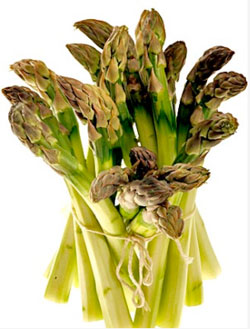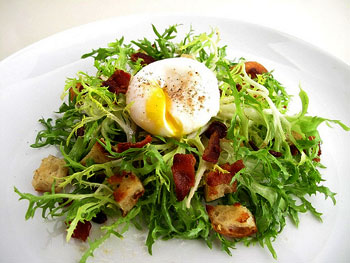 Cashier: Picking up the two fennel bulbs I was buying and examining them. "Do you cook with fennel a lot?"
Cashier: Picking up the two fennel bulbs I was buying and examining them. "Do you cook with fennel a lot?"
Me: "Oh, yeah. All the time."
Cashier: "I’ve always wondered what to do with it. It just looks so cool, you know?"
Me: "Oh, I can give you lots of idea about how to cook with fennel. You could put it in salads or saute --"
Cashier: Waving the hands as if she were trying to stop traffic, she interrupted, "Oh, no, no! I don't want you to tell me. I won’t actually do it. I’ve just always wondered."
In case you're wondering about fennel bulb, it's actually an herb that has been enjoyed since antiquity. When eaten raw, you'll appreciate its crunchy, refreshing celery-like texture and sweet licorice flavor. When sauteed or roasted, you'll find it morphs into something more savory, with an earthy depth of flavor. It gets along well with many ingredients but has a special affinity for citrus fruits, figs, olives, nuts, and hard cheese like Pecorino Romano and Parmesan. And those feathery fronds? They're edible too. Toss them in your salad or munch on them as a digestive aid.
Spring
Spring
Asparagus is a rite of spring
From the L.A. Times
 I'm wary of people who dig too deep for food metaphors, particularly when they involve religion, but if ever there were a case for a perfect pairing of produce and season, it would be asparagus and Easter.
I'm wary of people who dig too deep for food metaphors, particularly when they involve religion, but if ever there were a case for a perfect pairing of produce and season, it would be asparagus and Easter.
I love brightly colored eggs and bunny rabbits as much as the next guy. But if you want a concrete example of rebirth and the potential for new beginnings, just walk an asparagus field in early spring. What a few weeks before had been acres of brown raw dirt is now studded with hundreds of bright green asparagus spears poking through. In a month or so, the harvest finished, it will be a waist-high forest of ferns.
This is one metaphor that never fails to make me hungry. Over the last couple of weeks I've eaten asparagus for dinner at least three times. That may not seem like a lot, but when I say "eaten asparagus for dinner," that's just what I mean: My dinner was asparagus. OK, maybe some bread, too. And a glass of wine (though asparagus can be a tough match, Navarro Gewürztraminer is perfect).
The first night, I boiled it and dressed it with just a little very fruity olive oil, lemon juice and a generous sprinkling of crunchy sea salt. The next time, I steamed it and served it with a brown butter sauce and minced herbs.
Spring Salade Lyonnaise
 Salade Lyonnaise is one of the most popular salads in small French restaurants and bistros. In Lyon, from where the salad originates, it is typically found on the menus of tiny eateries called Bouchons, which specialize in comfort foods such as soups, stews, sausages, cheeses, etc. You can most certainly also find this salad served at Thomas Keller's Bouchon and at many of the restaurants of Lyon native Daniel Boulud. Comfort food knows no boundaries of class. It is simply just that popular that both high and low places offer it. And why wouldn't this salad be comforting? It is made of lettuce, croutons, bacon, and a poached egg perched on top.
Salade Lyonnaise is one of the most popular salads in small French restaurants and bistros. In Lyon, from where the salad originates, it is typically found on the menus of tiny eateries called Bouchons, which specialize in comfort foods such as soups, stews, sausages, cheeses, etc. You can most certainly also find this salad served at Thomas Keller's Bouchon and at many of the restaurants of Lyon native Daniel Boulud. Comfort food knows no boundaries of class. It is simply just that popular that both high and low places offer it. And why wouldn't this salad be comforting? It is made of lettuce, croutons, bacon, and a poached egg perched on top.
Inspired by all the gorgeous lettuces I saw at the Greenmarket on a sunny and warm last Friday, I knew this salad would be the one to make. Not only can it be put together in minutes, but it also features ingredients that most people have in their refrigerator or pantry at all times. Of course not including the fresh frisée, which is traditionally used in this recipe for it's unique texture, crunch, and slight bitterness. This salad makes such an impressive presentation: With the lettuce piled up just right, and the egg set in the center, it looks like a bird's nest. It's a lunch that presses all the comfort buttons, and it also can be a pleasing appetizer at a dinner party.
A Perfect Early Spring Day in Belgrade Maine
 As the sun rises over the chain of glacier-formed lakes, I revel in the beauty outside my window and the smells and sounds outside my door. It is so beautiful I want to take this moment to tell you about it. The beavers swim by half an hour before sunrise on their way to work and this doesn’t include freeway commuting, just a gentle swim to their hut nearly a quarter mile away. Then all the birds start their morning songs, the Osprey flies by casting a coppery shadow across my ceiling as the sun starts to rise. The loons are soulfully singing in the near distance and a single loon fishes diligently in the cove. It promises to be an even more beautiful day than yesterday. Spring is springing in all its glory!
As the sun rises over the chain of glacier-formed lakes, I revel in the beauty outside my window and the smells and sounds outside my door. It is so beautiful I want to take this moment to tell you about it. The beavers swim by half an hour before sunrise on their way to work and this doesn’t include freeway commuting, just a gentle swim to their hut nearly a quarter mile away. Then all the birds start their morning songs, the Osprey flies by casting a coppery shadow across my ceiling as the sun starts to rise. The loons are soulfully singing in the near distance and a single loon fishes diligently in the cove. It promises to be an even more beautiful day than yesterday. Spring is springing in all its glory!Boysenberry, a California treasure
From the L.A. Times
 To the uninitiated, the boysenberry may look like a big, blowzy, underripe blackberry, but it is in fact a noble fruit, as distinct from a common blackberry as a thoroughbred is from a mule.
To the uninitiated, the boysenberry may look like a big, blowzy, underripe blackberry, but it is in fact a noble fruit, as distinct from a common blackberry as a thoroughbred is from a mule.
Large, dark purple, juicy and intense, it derives its unique flavor from its complex ancestry: sweetness and floral aroma from its raspberry grandmother, and a winy, feral tang from three native blackberry species.
It's a California classic, emblematic of the joys of growing up in the Southland before it succumbed completely to sprawl. And it's all the more precious, despite its near extinction in this state, because it evokes why people moved here in the first place.
But Boysens can still be found if you know where to look, although their season is brief — late May to early July — and they are so delicate that as a fresh fruit they can be enjoyed at their best only from farmers markets, farm stands and home gardens.
More Articles ...
Welcome to the new One for the Table ...
Our Home Page will be different each time you arrive.
We're sure you'll find something to pique your interest...


